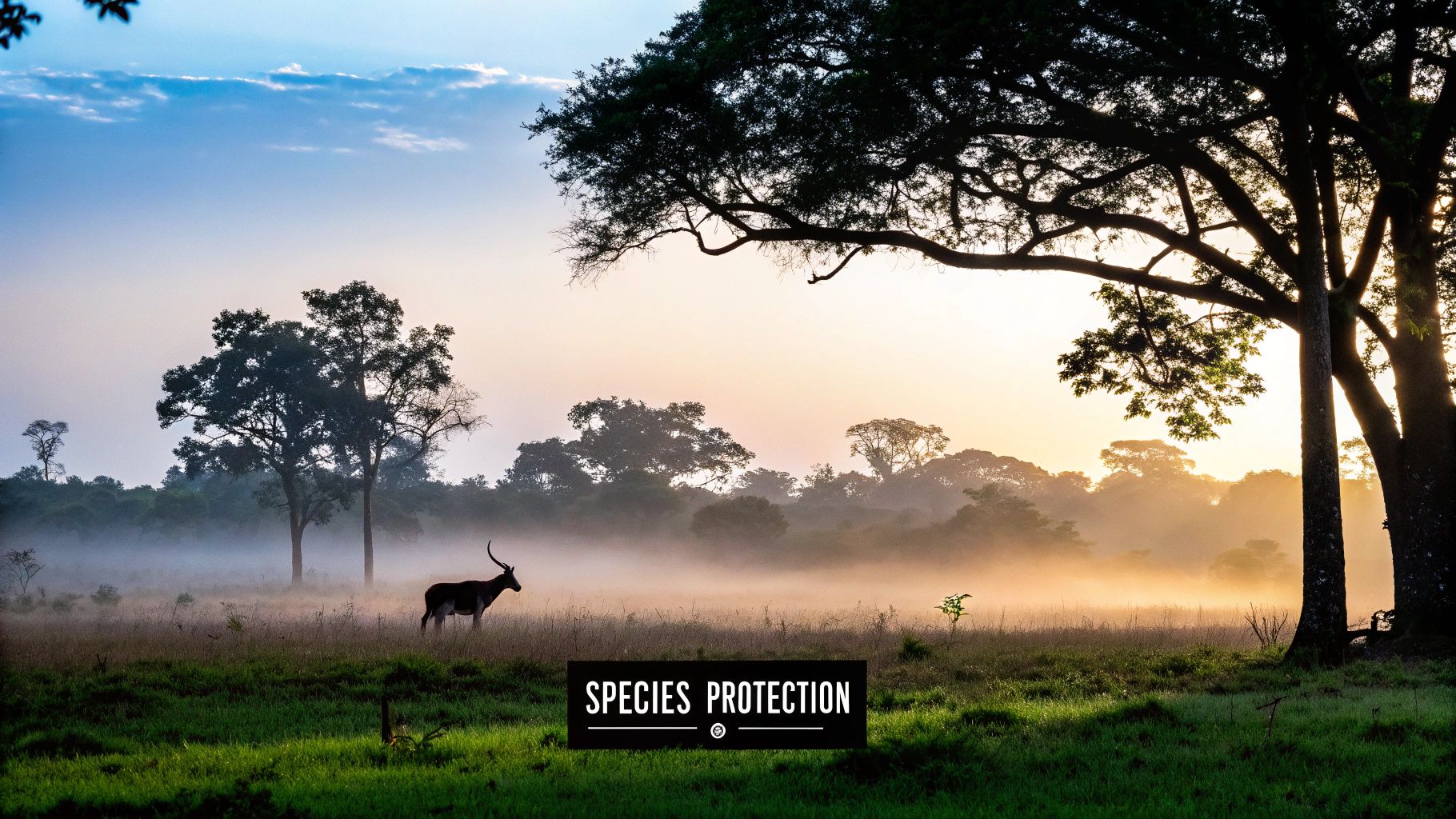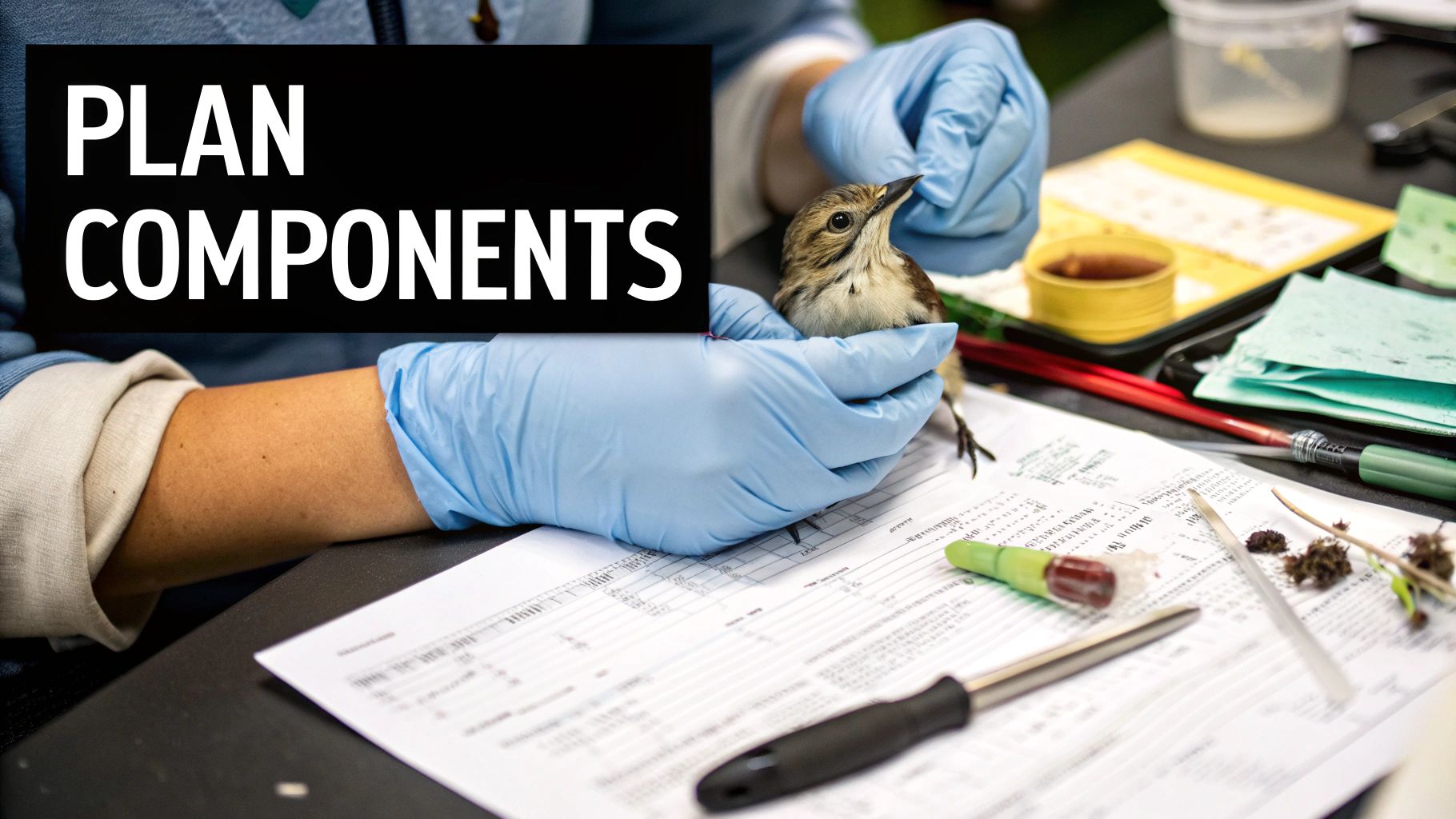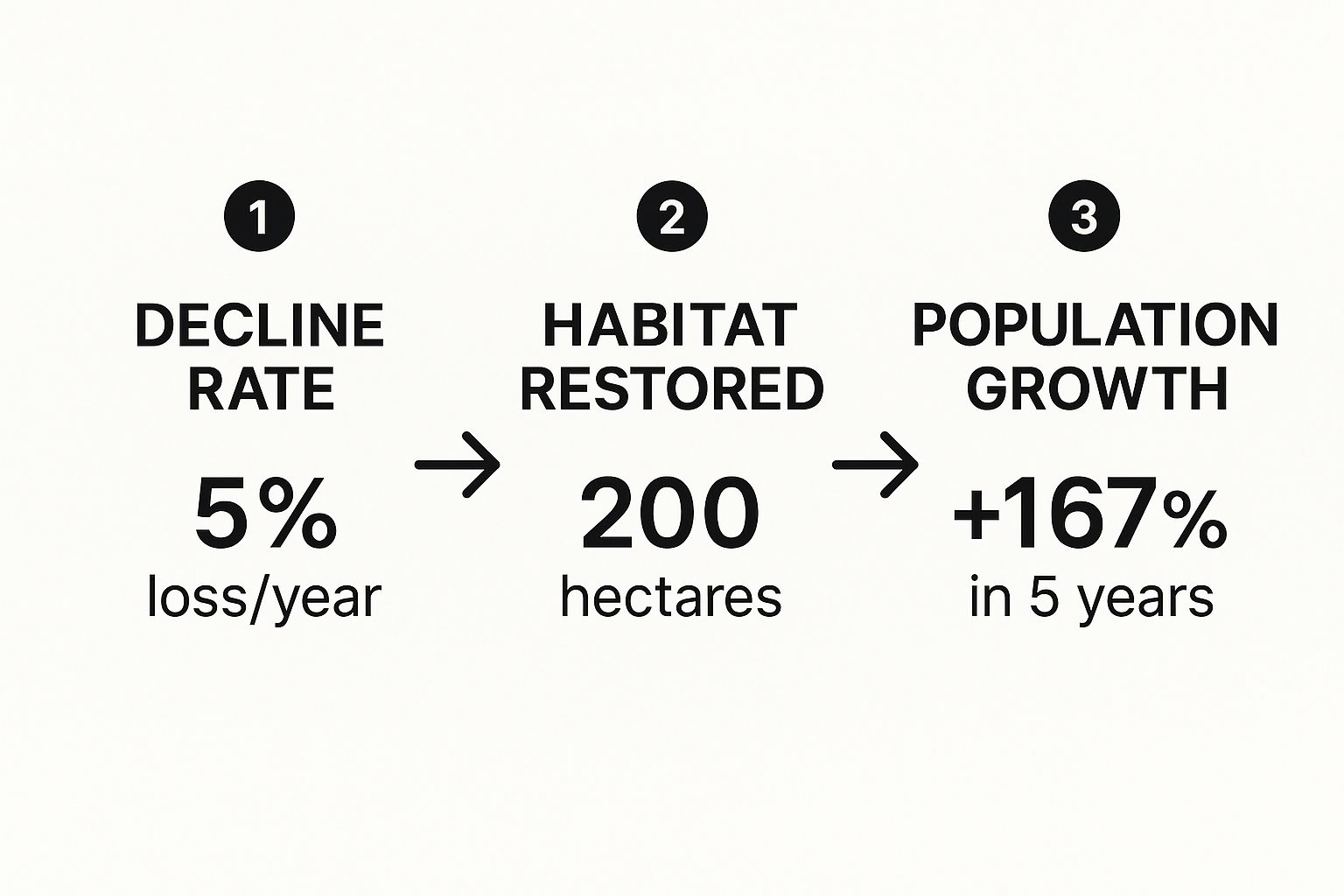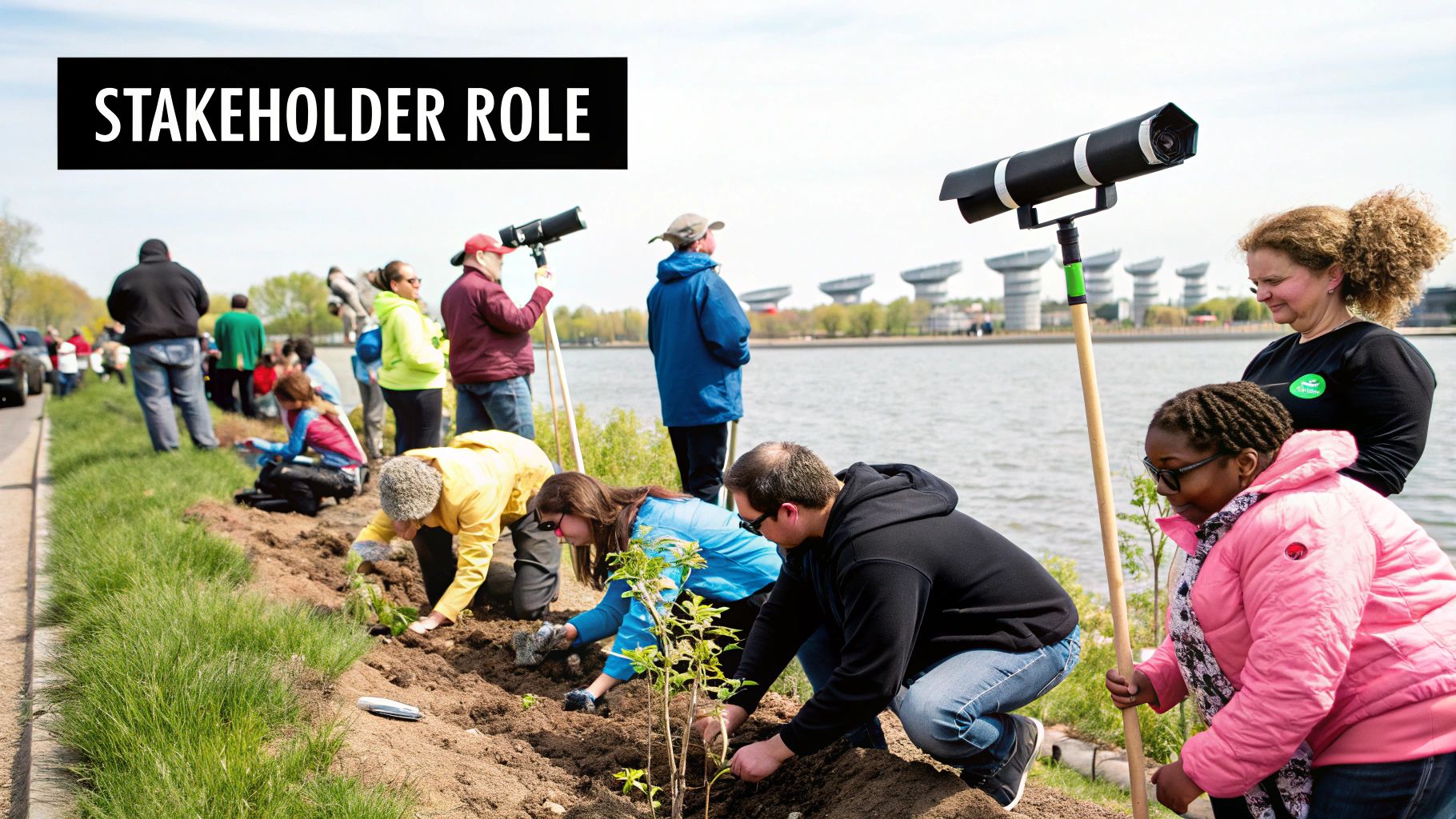When a species is teetering on the edge of extinction, you can't just hope for the best. You need a plan. An endangered species recovery plan is exactly that: a blueprint for survival, mapping out the precise, science-backed steps required to pull a species back from the brink.
What Exactly Is a Species Recovery Plan?

Think of it like a game plan for a team that's way behind in the final quarter. The coach doesn't just yell "play harder!" Instead, they draw up specific plays, assign roles, and define what a win looks like. A recovery plan does the same for an entire species facing overwhelming odds.
These aren't just stuffy government documents gathering dust on a shelf. They are living, breathing strategies that turn scientific research into real-world action. They act as the central playbook for everyone involved in the conservation of a specific animal or plant.
In many places, this isn't just a good idea—it's the law. In the United States, the Endangered Species Act (ESA) of 1973 mandates that these plans be created for most listed species. This landmark legislation ensures that all recovery efforts are guided by solid science and clear management objectives aimed at bringing a population back to health. You can find more about the legal framework of recovery planning from academic research.
The Core Purpose of a Recovery Plan
At its core, a recovery plan is built to answer a few critical questions, leaving no room for guesswork. It’s designed to be a comprehensive guide for anyone involved.
The main goals of any solid recovery plan are to:
- Pinpoint the Problems: The plan meticulously identifies every threat pushing the species toward extinction. This could be anything from habitat loss and pollution to climate change and competition from invasive species.
- Define Success: What does "recovered" actually mean? The plan sets specific, measurable benchmarks for a healthy and self-sustaining population. This gives everyone a clear finish line to work towards.
- Lay Out the Solutions: It details the exact actions needed to combat the threats and reach the recovery goals. These actions might include restoring habitat, starting captive breeding programs, or launching public awareness campaigns.
- Unite the Team: It brings together all the key players—federal and state agencies, scientists, non-profits, private landowners, and local communities—to pull in the same direction for a common cause.
A recovery plan is more than a document; it is a commitment. It transforms the goal of "saving a species" from a vague wish into a structured, accountable, and scientifically-grounded mission.
By creating this unified roadmap, these plans prevent well-intentioned but scattered efforts from failing. They ensure that every dollar spent and every hour of work is aimed squarely at the species' most critical needs, giving it the best possible shot at a secure future.
The Legal and Scientific Backbone of Recovery

For an endangered species recovery plan to actually work—to be more than just a hopeful document gathering dust on a shelf—it needs to stand on two solid pillars: strong legal backing and hard-nosed scientific evidence. These are the twin forces that give a plan its teeth and its brains, turning good intentions into real, measurable progress.
Think of the legal framework as the engine. It provides the power and the authority to get things done. In the United States, that engine is the legendary Endangered Species Act (ESA) of 1973. This wasn't just a suggestion; it was a game-changer. The ESA legally requires federal agencies to develop and implement recovery plans for most listed species. This mandate gives organizations like the U.S. Fish and Wildlife Service the legal muscle they need to protect habitats and make tough decisions.
This legal requirement is everything. It makes recovery a core government responsibility, not an optional side project. On a global scale, groups like the International Union for Conservation of Nature (IUCN) set the standards, helping coordinate efforts worldwide. For anyone asking how to protect endangered species, understanding these legal frameworks is the first step, as they are what authorize the work on the ground.
The Science That Guides The Action
If the law is the engine, then science is the GPS. It provides the intelligence, the data, and the roadmap. A modern recovery plan isn't based on guesswork. It's built from the ground up on scientific assessments that diagnose a species' problems with incredible detail.
This scientific foundation ensures we're not just throwing money at a problem but making smart, targeted investments. Some of the go-to tools in the scientific toolbox include:
- Species Status Assessments (SSAs): You can think of an SSA as a full-body medical exam for a species. It’s a deep dive into population numbers, genetic health, habitat quality, and all the threats a species is facing. It tells us, "How sick is the patient, really?"
- Population Viability Analysis (PVA): This is where scientists play fortune-teller, but with sophisticated computer models. A PVA helps predict a population's future. What happens if we protect 500 more acres? What if a new disease appears? This modeling helps us test-drive conservation strategies before we spend a dime.
These methods are what shift conservation from just reacting to crises to proactively planning for success. We get a much clearer picture of what a species truly needs to thrive, which lets us design smarter, more effective actions.
This marriage of law and science is incredibly powerful. The ESA gives us the "why" and the legal authority, while the SSAs and PVAs give us the "what, where, and when."
Building a Plan on a Solid Foundation
This combination is what makes every action in a recovery plan both defensible and effective. When a plan calls for restoring a particular stretch of river or reintroducing a specific number of animals, that decision isn't arbitrary. It’s backed by a legal mandate and the best available science.
The table below breaks down the key components that come together to form a modern, effective recovery plan, all resting on this dual foundation.
Key Components of a Modern Recovery Plan
| Component | Purpose and Description |
|---|---|
| Legal Mandate | Provides the official authority to create and implement the plan. It forces agencies to act and helps secure cooperation across different departments. |
| Scientific Assessment | Uses tools like SSAs to get a complete picture of the species' biology, threats, and habitat needs. This evidence forms the basis for every action item. |
| Recovery Criteria | Sets clear, measurable benchmarks for success based on scientific data. This defines exactly what a "recovered" population looks like in real numbers. |
| Public Accountability | The legal process usually requires public comment periods. This keeps the process transparent and allows local communities and stakeholders to have a say. |
In the end, it’s this blend of legal authority and scientific rigor that gives a recovery plan its true power. It ensures these plans are more than just wishful thinking—they are strategic, accountable blueprints designed to pull our most vulnerable species back from the very edge.
Unpacking the Four Phases of Species Recovery
Bringing a species back from the brink is a marathon, not a sprint. An endangered species recovery plan isn't a single document or one magic-bullet action. It’s a long-term commitment that unfolds in a series of careful, deliberate stages. Each phase builds on the last, guiding a species from a crisis point toward stability and, with a bit of luck and a lot of hard work, self-sufficiency.
Think of it like building a community health clinic. You wouldn't just show up and start laying bricks. First, you’d need to understand the community's most pressing health issues. Then, you'd hire an architect to draw up blueprints. After that comes the long, hands-on process of construction and actually running the clinic. Finally, you'd keep an eye on things with long-term health screenings to make sure the community stays healthy on its own.
Species recovery follows a similar, logical path. The U.S. Fish and Wildlife Service (FWS) breaks this journey down into four distinct phases, creating a structured approach that keeps everything grounded in science and collaboration. This federal framework provides a clear roadmap for the long-term work involved, which you can explore further in this report on species recovery efforts from Oversight.gov.
Phase 1: Pre-Planning and Assessment
This is the "boots on the ground" discovery phase. Before anyone even thinks about writing a formal plan, scientists and conservation managers dive deep, gathering every scrap of information they can find about the species. They're trying to answer the big questions: Just how bad is it? And what are the biggest threats we need to tackle first?
It’s a bit like that initial community health survey—you have to diagnose the problem before you can prescribe a solution. This stage involves an exhaustive look at the species' biology, behavior, and habitat needs. The main goal here is often to produce a Recovery Outline, which acts as a first draft of the strategy, highlighting the most urgent actions and identifying who needs to be at the table.
Phase 2: Formal Recovery Planning
With a solid diagnosis in hand, it's time for the architectural phase: drafting the official recovery plan. This is where the rough sketches from phase one get fleshed out into a detailed, science-backed blueprint for action. This doesn't happen overnight. It requires a massive collaborative effort between federal agencies, state governments, academic experts, and other key partners.
During this phase, the team puts together a few critical documents:
- Species Status Assessment (SSA): A deep-dive scientific report on the species' current health and long-term viability.
- Recovery Plan: The official playbook that spells out the recovery goals, the criteria for success, and the specific actions needed.
- Recovery Implementation Strategy (RIS): A prioritized to-do list of on-the-ground activities, complete with timelines and estimated costs.
This is the blueprint that will guide every single action moving forward, making sure everyone is working from the same game plan.
Phase 3: Implementation and Monitoring
Now the real work begins. Phase three is where the plan moves off the paper and into the real world. This is the longest and most active part of the journey, often spanning decades. It’s the sustained, on-the-ground effort to turn goals into reality.
Actions in this phase can be incredibly varied and might include things like:
- Restoring and protecting critical habitats.
- Running captive breeding and reintroduction programs.
- Partnering with private landowners to encourage conservation-friendly land use.
- Launching public outreach campaigns to get the community on board.
Throughout it all, constant monitoring is key. Teams are always tracking population numbers, checking on habitat conditions, and measuring how well their actions are working, ready to pivot and adjust their strategy as needed.
This infographic is a great example of how a targeted action can completely flip the script for a struggling species.

You can see the direct line from a specific action—habitat restoration—to a huge, positive outcome for the species.
Phase 4: Post-Recovery and Delisting
What's the ultimate goal of any recovery plan? To make itself unnecessary. When a species finally meets the specific, measurable goals laid out in its plan, it can be "delisted," or removed from the protections of the Endangered Species Act.
This is a monumental achievement, but it doesn't mean the work is over. The final phase involves a period of post-delisting monitoring, typically lasting for at least five years.
Think of it as the long-term health screenings for our clinic. Scientists keep a close watch on the population to make sure it stays stable without all the intensive support. If there are any signs of trouble, protections can be put back in place, ensuring that decades of hard work aren't lost. It’s the final, crucial step to secure a lasting legacy of recovery.
Inside a Recovery Plan: What Makes It Work?

So, what exactly is inside an endangered species recovery plan? Think of it less like a dry government report and more like a detailed game plan for bringing a species back from the brink. It’s the roadmap that turns good intentions into real, measurable action.
To make that happen, every plan is built on a few core, non-negotiable elements. Let's pop the hood and see what makes these things tick.
Defining What Success Looks Like
At the heart of every solid recovery plan are its recovery criteria. These are the clear, specific, and measurable goals that tell everyone, "This is what success looks like." You can't win a race if you don't know where the finish line is, right? It's the same principle here.
These aren't just vague goals like "help the population grow." They are incredibly specific benchmarks tailored to the unique biology and needs of each species. For a grizzly bear, recovery might look completely different than it does for a tiny, rare butterfly.
A plan might spell out that a species will be considered recovered only when:
- There are at least 2,000 breeding adults in the wild.
- These animals are distributed across three separate, self-sustaining populations.
- The population has stayed at this level for 10 straight years without major human help.
This level of detail is absolutely essential. It takes all the guesswork out of the equation and gives conservation teams a clear, science-backed target to aim for. The laws that require these plans, which we cover in our guide to endangered species protection laws, rely on these concrete goals to ensure accountability.
The Action Items That Drive Progress
Once the finish line is defined, the plan lays out the how—the specific tasks and management actions needed to get there. This is where the real work happens. These aren't just suggestions; they are prioritized actions designed to tackle the biggest threats the species faces.
You'll typically see a combination of actions, such as:
- Habitat Restoration and Protection: This can be anything from replanting native trees and pulling out invasive weeds to getting legal protection for critical nesting sites.
- Captive Breeding Programs: When a species' numbers are dangerously low, programs in zoos or conservation centers can build up a healthy population for reintroduction into their natural habitat.
- Public Outreach and Education: You can't save a species without the support of the local community. These efforts help people understand why the species matters and what they can do to help.
A recovery plan is where science meets accountability. It’s a detailed list of who needs to do what, by when, and how much it’s expected to cost, ensuring that the process is transparent and grounded in reality.
Finally, the plan includes timelines and cost estimates. This is what keeps everything grounded and realistic. It makes it clear that a recovery plan isn't just a wish list—it's a serious project with deadlines, budgets, and clear responsibilities. This ensures the mission to save a species is managed with focus and purpose, giving it the best possible shot at success.
Real-World Recovery Successes and Setbacks
The theory behind endangered species recovery plans is one thing, but where the rubber really meets the road is out in the wild. This is where the story of conservation unfolds, full of incredible wins and, sometimes, heartbreaking setbacks. These plans are often the only thing standing between a species disappearing forever and making a comeback for the ages.
When they work, the results can be truly spectacular.
Just look at the Bald Eagle, probably the most famous conservation success story in the United States. Their population was decimated by the pesticide DDT, which caused their eggshells to become so thin they'd break during incubation. A powerful, coordinated recovery plan changed everything. It included a nationwide ban on DDT in 1972, serious efforts to protect their habitat, and captive breeding programs. The multi-front attack worked, and in 2007, the Bald Eagle was officially removed from the Endangered Species List. It’s a powerful reminder of what's possible with a focused strategy.
The American Alligator has a similar comeback story. Hunted to the brink of extinction, its population roared back thanks to strict hunting laws, habitat management, and a big public education push. They recovered so well that they were delisted way back in 1987. These examples prove that even species teetering on the edge of oblivion can be brought back.
The Major Hurdles in Conservation
But let's be honest—not every story has such a happy ending. The path to recovery is often a bumpy one, and many dedicated people on the ground find themselves fighting an uphill battle. The journey is rarely as straightforward as it was for the alligator.
The roadblocks tend to fall into a few familiar, frustrating categories:
- Chronic Funding Shortages: Recovery work is expensive. You need sustained investment to restore habitats, run breeding programs, and monitor populations. Unfortunately, the funding that comes through is often just a fraction of what’s actually needed to get the job done right.
- Political Roadblocks: Conservation can easily become a political football. When governments change, so do priorities and budgets. In some cases, officials simply fail to create or update recovery plans as required by law, leaving species stuck in a dangerous limbo for years on end.
- Habitat Fragmentation: You can't save a species if you don't save its home. It's that simple. Yet urban sprawl, agriculture, and new infrastructure keep carving up vital habitats. This isolates animal populations, making it a struggle for them to find food, connect with mates, and secure safe territory.
These challenges expose the gap between good intentions and effective action. The framework for recovery is there, but success hinges on our ability to overcome these persistent, real-world problems.
The Sobering Reality of Global Conservation
The sheer scale of the biodiversity crisis makes this work more urgent than ever. The numbers are pretty stark: the International Union for Conservation of Nature (IUCN) has assessed over 166,000 species and found that about 28% of them are currently threatened with extinction.
A landmark study confirmed what conservationists have known for years: nearly every species that has shown improvement had specific conservation actions helping them. The plans work. Yet, only about half of the world's assessed species have any conservation actions in place at all. Worse, for every one species that has improved its conservation status recently, about six have declined. You can read more about these findings in a summary of global conservation efforts on ScienceDaily.com.
This gap between knowing what to do and actually doing it is the single greatest challenge in modern conservation. For every Bald Eagle success story, there are countless other species still waiting for their chance.
And now, the growing threat of climate change is throwing another wrench in the works. Shifting temperatures, wild weather, and changing ecosystems create entirely new pressures that can undermine even the most well-designed plans. This balanced view—celebrating the wins while being brutally honest about the immense work ahead—is what gives us a realistic, yet hopeful, perspective on the resilience needed to save our planet’s wildlife.
Got Questions About Species Recovery? We’ve Got Answers.
Even after diving deep into the world of endangered species recovery plans, you might still have a few things you're wondering about. That's perfectly normal! Let's tackle some of the most common questions to clear up any lingering confusion and give you a complete picture of how this all works in the real world.
How Long Does a Species Recovery Plan Actually Take?
That’s the million-dollar question, and the honest answer is: it completely depends. Recovery is a marathon, not a sprint, and there's no magic number. The timeline is dictated by the species itself and the challenges it faces.
Some plans might hit their targets in a couple of decades, which in the conservation world is a pretty quick win. But many are in it for the long haul. Take the Conasauga logperch, a little freshwater fish. Its recovery plan is estimated to take 30 years or more. Why so long? You have to factor in how fast it reproduces, the scale of habitat that needs restoring, and how tough its threats are to solve.
The big takeaway here is that recovery is a long-term commitment. It demands incredible patience and consistent effort, often spanning generations of scientists, advocates, and community members.
This perspective is what keeps everyone grounded and ensures these programs get the steady support they need to see a species all the way back to safety.
Who Foots the Bill for All This?
Paying for a species recovery plan is a true team effort. It’s a lot like funding a major public park or a new hospital—no single group can cover the cost alone.
A good chunk of the money comes from federal agencies like the U.S. Fish and Wildlife Service, allocated through government budgets. But federal dollars almost never stretch far enough to cover everything a comprehensive plan needs.
That's where a whole network of other supporters steps in. It’s a real patchwork of funding:
- Non-Governmental Organizations (NGOs): Powerhouses like the National Wildlife Federation and The Nature Conservancy raise millions from private donors to fuel boots-on-the-ground conservation.
- Private Landowners: Many ranchers, farmers, and other landowners partner up, offering their land for habitat work in exchange for support and resources.
- State and Local Agencies: State wildlife departments are crucial partners, often pitching in with their own funding and staff for efforts within their borders.
- Corporate Partners and Foundations: Some businesses and charitable foundations step up to provide grants and sponsor specific projects that align with their values.
This mix-and-match funding model is what pieces together the resources needed to make recovery happen.
Can an Ordinary Person Really Help with Species Recovery?
Absolutely, yes! You don't need to be a field biologist to make a real, tangible difference. Your actions, whether big or small, are a vital part of the broader conservation mission.
Here are a few powerful ways you can jump in:
- Support and Volunteer: Donating to or volunteering with reputable conservation groups puts your money and time directly into the work that matters.
- Create a Wildlife-Friendly Yard: Turn your own patch of earth into a mini-refuge. Plant native flowers, set out a water source, and ditch the harsh chemical pesticides.
- Become an Advocate: Use your voice! Contact your elected officials and tell them you support strong conservation laws and full funding for recovery programs.
- Spread the Word: Simply talking to your friends and family about why this matters is huge. Passion and awareness are contagious.
Every single one of these actions helps build a culture of conservation, which is the foundation for any long-term success.
What Happens After a Species Is Considered "Recovered"?
Hitting all the recovery goals and getting a species "delisted" from the Endangered Species List is a massive victory lap for conservation. But the job isn't quite finished yet.
The law requires a post-delisting monitoring period of at least five years, though it often goes on for longer. During this phase, scientists keep a close eye on the population to make sure it's staying stable and healthy without all the intensive human help.
Think of it as a final wellness check after a long hospital stay. If the species starts to struggle again or old threats pop back up, protections can be put back in place quickly. This final step ensures that all the decades of hard work, funding, and dedication weren't for nothing, securing a lasting future for the species.
At William Tucker Art, we believe that art is a powerful bridge to the natural world, inspiring us to protect the wild beauty we all cherish. Each piece, from our vibrant wildlife paintings to our delicate bee-themed jewelry, is a celebration of nature's strength and a reminder of what we're fighting for.
Explore our collections and discover art inspired by nature at williamtuckerart.com
